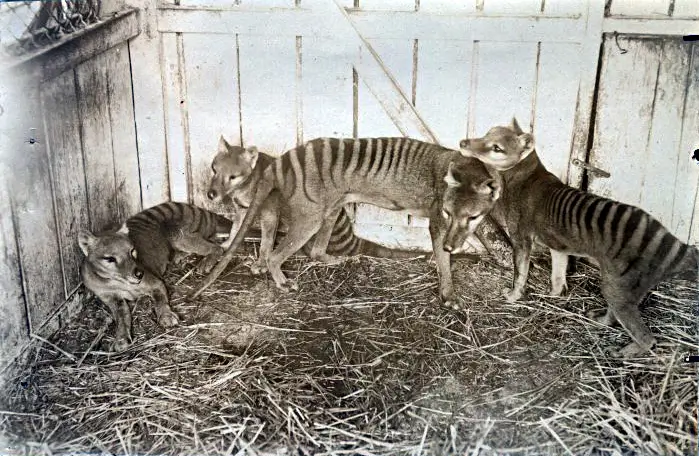Thylacine
Thylacinus cynocephalus
Marsupialia - Dasyuromorphia - Thylacinidae - Thylacinus
The Thylacine, a carnivorous marsupial native to Tasmania, Australia, once also roamed the Australian mainland and New Guinea. However, due to factors such as climate changes and the introduction of competitors, their populations on the mainland had already dwindled by the time European settlers arrived, leaving only those in Tasmania. Known as “袋狼” (Dàiláng) in Chinese, meaning “marsupial wolf,” the Thylacine is also commonly referred to as the “Tasmanian Tiger” in the Western world due to its tiger-like stripes. Despite these similarities, the Thylacine’s evolutionary relationship with non-marsupial carnivorous mammals is distant, with their resemblances resulting from convergent evolution.
The Thylacine was the last surviving member of the family Thylacinidae after the Pleistocene until its extinction in the Holocene, occupying a unique position in phylogenetics. The Thylacinidae family belongs to the order Dasyuromorphia, which includes most carnivorous marsupials. Other members of this family have been discovered through fossils. Modern DNA sequencing has shown that the Thylacinidae is the basal group within Dasyuromorphia1, with the family diverging around 36 to 42 million years ago. The genus Thylacinus, which includes the modern Thylacine, began to evolve independently between 8 to 13.5 million years ago2.
Adult Thylacines resembled canids in size and shape, measuring about 1.8 meters in total length, with their long, stiff tails accounting for one-third of this length (50-65 cm). They stood approximately 60 cm tall at the shoulder. 3 Their short, coarse fur was light brown with 13-20 dark brown transverse stripes running from the base of the tail to the shoulders. The tail itself had similar coloring and striping. 4 Both male and female Thylacines had pouches, but only the females used theirs for rearing young.
Thylacines primarily inhabited open forests and grasslands. They were nocturnal hunters, preying on small mammals, including marsupials, rodents, and birds. Rather than relying on speed, Thylacines used endurance to exhaust their prey. Breeding occurred around winter (December), with young Thylacines maturing in the mother’s pouch. They remained with their mother, hidden in a den while she foraged, until they were independent enough to hunt. 3
Thylacines survived on mainland Australia until around 1100 BCE, becoming extinct there along with Tasmanian devils (Sarcophilus harrisii). 5 This extinction was likely due to human activities, competition with the dingo (Canis lupus dingo), and climate change. The Tasmanian population persisted until the early 20th century 6 but was eventually driven to extinction by human hunting, loss of genetic diversity due to island evolution, and disease. The last known Thylacine died in Hobart Zoo on September 7, 1936.
The Thylacine is one of the most frequently reported “reappearing” extinct animals, offering hope yet often leading to disappointment. Since 1936, there have been numerous unverified sightings, some seemingly credible, but no official scientific expeditions have confirmed the Thylacine’s existence.

-
Miller, Webb, et al. “The mitochondrial genome sequence of the Tasmanian tiger (Thylacinus cynocephalus).” Genome research 19.2 (2009): 213-220. ↩︎
-
Rovinsky, Douglass S., Alistair R. Evans, and Justin W. Adams. “The pre-Pleistocene fossil thylacinids (Dasyuromorphia: Thylacinidae) and the evolutionary context of the modern thylacine.” PeerJ 7 (2019): e7457. ↩︎
-
Bryant, Sally, and Jean Jackson. “Tasmania’s threatened fauna handbook.” Parks and Wildlife Service Tasmania, Hobart (1999). ↩︎ ↩︎
-
Threatened Species: Thylacine – Tasmanian tiger, Thylacinus cynocephalus. parks.tas.gov.au. Parks and Wildlife Service, Tasmania. December 2003. ↩︎
-
White, Lauren C., et al. “High-quality fossil dates support a synchronous, Late Holocene extinction of devils and thylacines in mainland Australia.” Biology Letters 14.1 (2018): 20170642. ↩︎
-
Based on numerous unverified sightings, Brook et al. suggested in a 2023 study that Thylacines might have survived into the 1980s. See: Brook BW, Sleightholme SR, Campbell CR, Jarić I, Buettel JC. 2023. Resolving when (and where) the Thylacine went extinct. Science of The Total Environment. 877:162878. doi:https://doi.org/10.1016/j.scitotenv.2023.162878. ↩︎